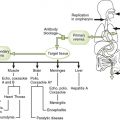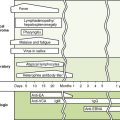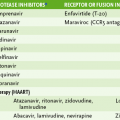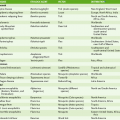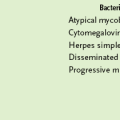Chapter 12 • Neisseria meningitidis and Neisseria gonorrhoeae are strict human pathogens; other Neisseria species are commonly present on mucosal surfaces. • Gram-negative, nonmotile, coffee bean–shaped diplococci • Loosely attached outer membrane that is readily shed, releasing lipooligosaccharide (LOS) into the host a. LOS contains lipid A (endotoxin) and core oligosaccharide found in lipopolysaccharide (LPS), but it lacks strain-specific O antigen found in LPS of most gram-negative bacteria (see Chapter 6, Fig. 6-6). 2. Growth and biochemical characteristics • N. meningitidis enters the respiratory tract, invades mucous membranes, and spreads via the bloodstream. • Antiphagocytic capsule is important for virulence. • Released endotoxin induces fever and increases vascular permeability, potentially leading to shock and petechiae (capillary leakage in skin). • Meningococcal infection is most common in children younger than 5 years of age and in those with deficiency of terminal complement components (C5-C9). a. Septicemia with or without meningitis b. Characterized by fever, shock, and generalized hemorrhage ranging from petechiae to purpura c. Can be rapidly fatal (mortality rate of 25% or higher) if not treated promptly • Waterhouse-Friderichsen syndrome a. Complication of meningococcemia b. Marked by overwhelming disseminated intravascular coagulation and bilateral hemorrhagic adrenal infarctions with septic shock, acute hypotension, tachycardia, and petechiae • Mild febrile disease with pharyngitis, pneumonia, arthritis, or urethritis 4. Transmission of N. meningitidis • Person-to-person spread from infected persons • Inhalation of aerosol droplets (often from asymptomatic posterior nasopharyngeal carriers) • Breastfeeding infants for the first 6 months of life • Active immunization of children older than 2 years of age with a polyvalent conjugate, anticapsular vaccine (not effective against serogroup B) • Postexposure prophylaxis with rifampin, quinolones, or sulfonamides (only if the organism is proved susceptible) 1. Thayer-Martin medium (selective chocolate agar) • Used for isolating N. gonorrhoeae in specimens from nonsterile areas, such as the cervix and urethra • Contains vancomycin (kills gram-positive bacteria), colistin (kills gram-negative bacteria except Neisseria species), and nystatin (kills fungi)
Gram-Negative Cocci and Coccobacilli

